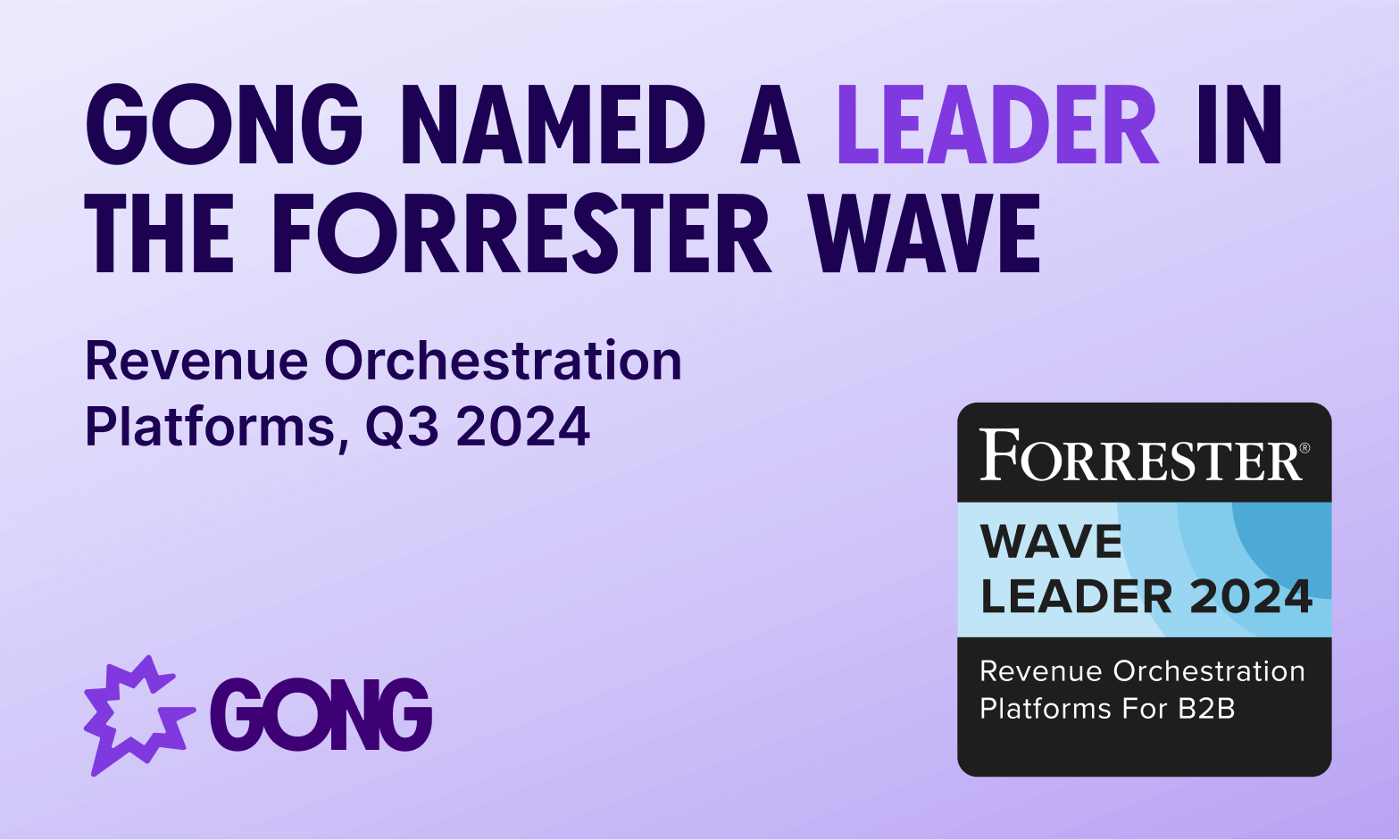How to accurately forecast your sales in 6 steps
If you’ve worked more than one month in sales, you know that the new quarter starts the minute after the last one ends.
And most sales teams consistently measure throughout the quarter how their performance is tracking to their goals.
We call this process sales forecasting.
Sales forecasting is critical for setting revenue and sales targets, planning resources and new hires, and managing company cash flow.
In this article, you’ll get a 101 on this crucial process. You’ll learn why it’s critical to your team’s success, who is responsible for sales forecasting, and, of course, how to build a sales forecast yourself.
What is a sales forecast?

A sales forecast is an estimate of expected revenue for a given period.
For example, if you’re doing a sales forecast for next month, you’re asking (and answering): “How much revenue can we expect to see from future sales?”
Sales forecasts are not guesses, however.
They’re calculated estimates based on an analysis of factors such as current sales pipeline, previous sales history, total addressable market, and lead stage scoring.
As such, they provide important insights into a business’s ability to reinvest in growth initiatives, highlight requirements for hiring and resourcing, and inform company budgeting.
We know it sounds a bit nerdy, but we’ll break down the sales forecasting methods for you shortly, and you’ll understand that it isn’t so hard if you’ve got the right data.
Why is sales forecasting such a crucial activity?
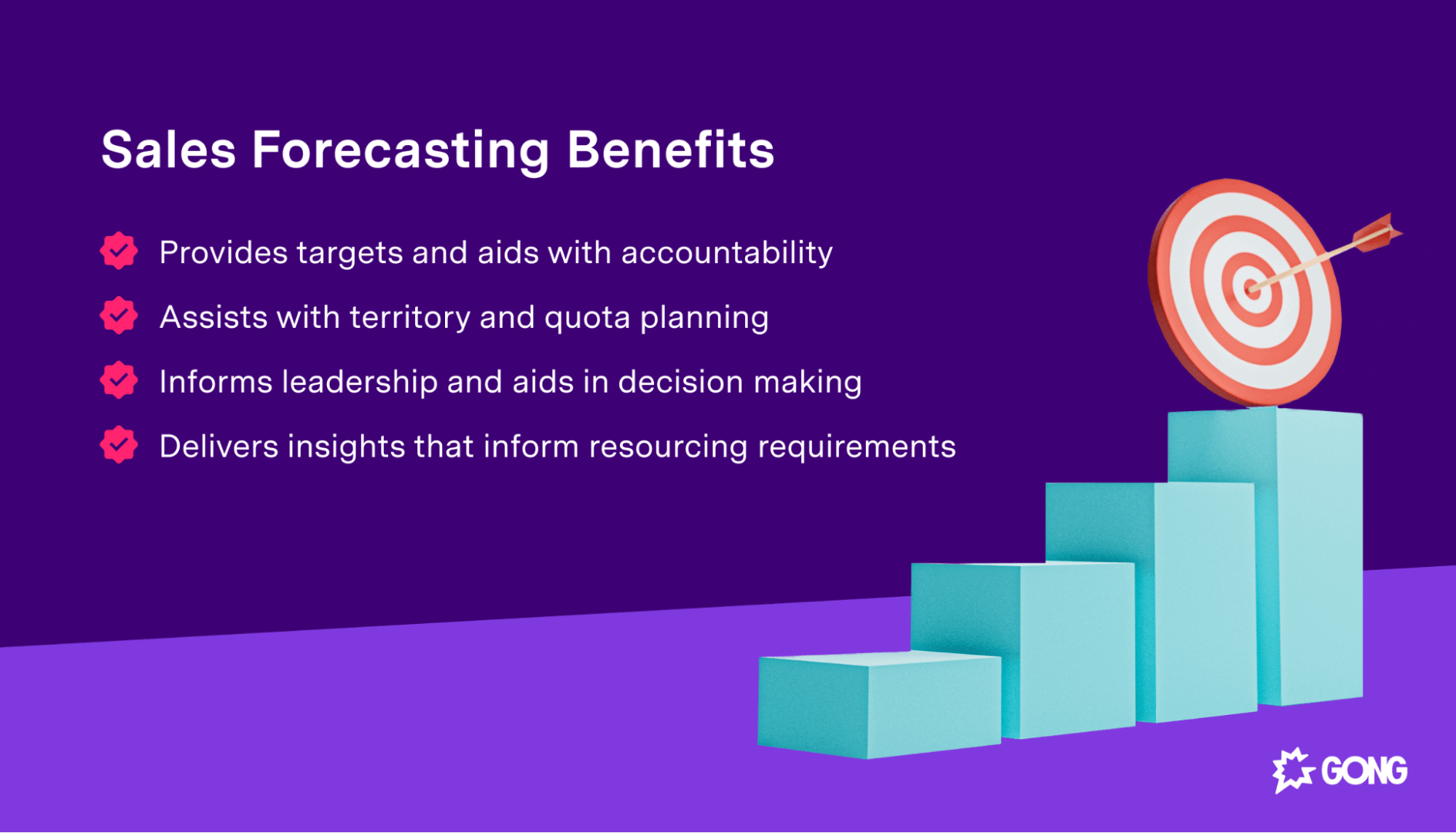
So, why bother with sales forecasts in the first place?
After all, what’s going to happen is going to happen. Putting some estimates down on paper isn’t going to impact what happens with each individual sale, right?
Maybe, but sales forecasting affords companies a bunch of benefits.
First off, forecasting helps sales leaders set realistic targets, helping them to hold sales reps accountable to quotas that are actually attainable.
Sales managers use forecasts for territory planning as well. If you know that next quarter, you’ve got an expected $250k in revenue from one territory and only $100k in expected revenue from a second; you can more appropriately allocate resources to the more lucrative geography.
Sales forecasts are also put to use further up the management chain.
Senior leadership needs to know with as much accuracy as possible how much revenue they can expect to see in the next financial period so they can make more informed budgeting and spending decisions, such as expanding the sales team to target a new territory or doubling down on inbound marketing tactics to drive lead generation.
They’ll also use your sales forecasts to inform:
- Resource planning and hiring
- Inventory and equipment purchases
- The need for any strategic interventions (if the forecast is significantly below budget)
What are the types of sales forecasting?
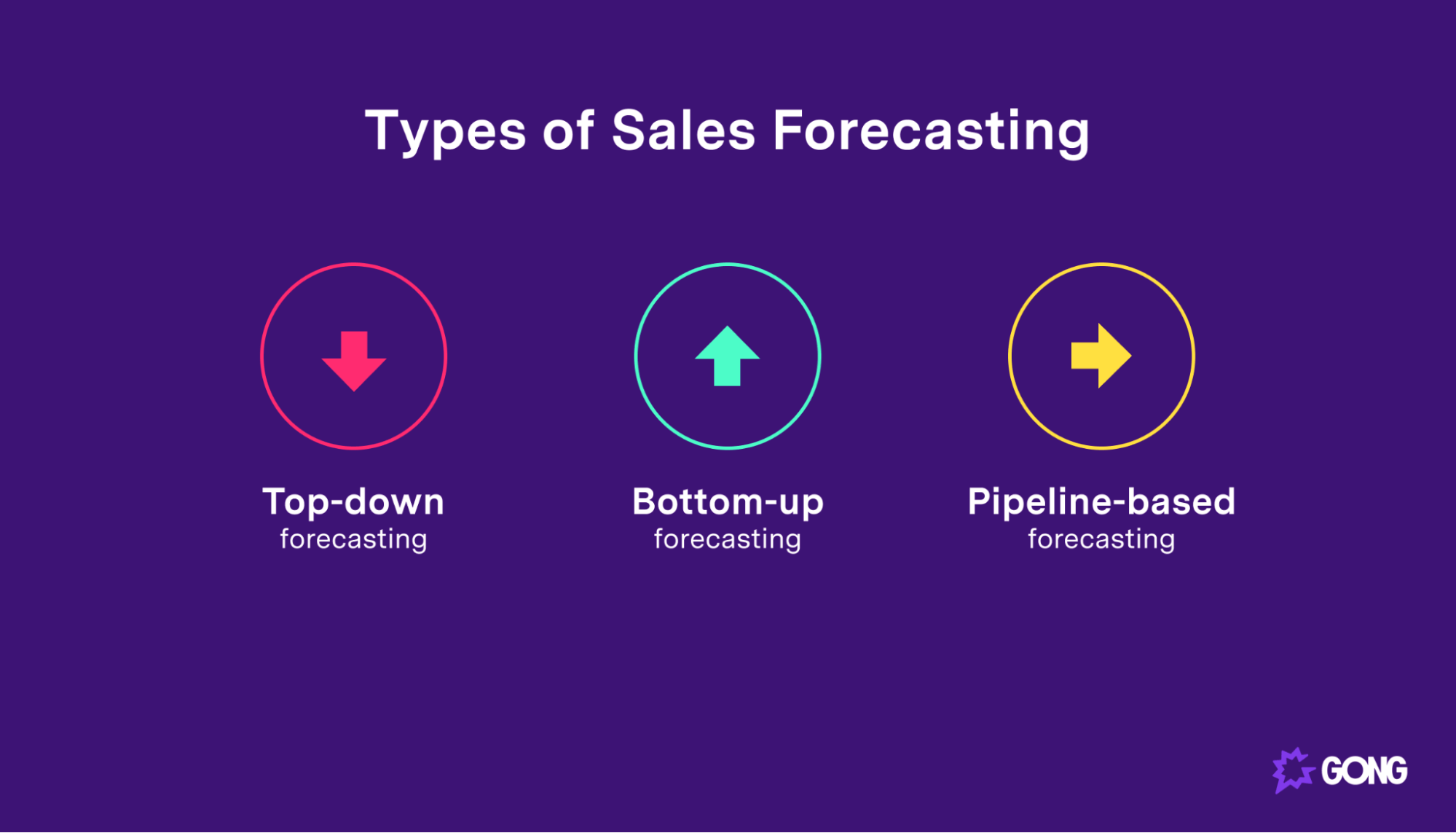
As with most things sales-related, there’s not a whole lot of consensus on how to create a sales forecast.
There are a few common sales forecasting methods, however, and the important thing is that you stick to the same methodology for all forecasts, for consistency,
Here are the three most common ways to skin the sales forecasting cat.
Top-down forecasting
Top-down forecasting is a market-driven approach.
In a top-down sales forecast, you first look at the total addressable market. That is, what is the maximum revenue potential from all possible customers in this sector?
From there, you apply your market share (as a percentage) to calculate forecasted revenue.
For instance, if your total addressable market size is $20m, and you have a 10% market share, then you can forecast $2m in sales revenue.
To be honest, this isn’t the most sophisticated form of sales forecasting. The obvious problem is that it doesn’t consider your sales team’s abilities and any current opportunities.
It’s also not particularly future-focused. Your market share is based on previous performance, not viable future opportunities.
In addition, the total addressable market is the total market, meaning it doesn’t take into account the readiness of any of these buyers — just because a company is part of the addressable market doesn’t mean they’re anywhere close to having a need for your product.
So, top-down forecasting should be used as a quick estimate and a yardstick but shouldn’t be used on its own as an accurate sales forecasting methodology.
Bottom-up forecasting
The bottom-up approach is a little better because it takes into account historical company data and looks at the actual opportunities in your sales pipeline to estimate revenue for the next month or quarter.
This is the most reliable method for an accurate sales forecast because it considers real-life opportunities and real-time sales likelihoods (based on sales rep intuition and historical results).
With bottom-up forecasting, you’ll look at each deal individually and assess:
- What’s likely to close and when
- What’s at risk and why
- What’s the expected revenue from each deal
Then, you’ll roll up a number that’s the sum of everything you have that reps are currently discussing and are confident about, and that will be your sales forecast.
Say, for instance, you have 10 deals in your pipeline currently. For the sake of simple calculation, each of them is worth $200,000 in revenue.
You’ll go through each deal with the rep who owns it, and determine the percentage likelihood that each will close. Say two of them are 90% likely to choose, six are 60% likely, and the last two are only 20% likely.
Then, you’ll wrap up the following figures:
- $200,000 x 2 x 90% = $360,000
- $200,000 x 6 x 60% = $720,000
- $200,000 x 2 x 20% = $80,000
In this case, your sales forecast would be $1.16m for the period.
Need more examples to get started?
Check out these 6 sales forecast examples to learn how to call your number with confidence.
Sales forecasts: responsibilities, objectives, and uses
Still not quite sure what sales forecasting is all about? Let’s answer a few more of your burning questions.
Who is responsible for sales forecasting?
This depends a little on the size and structure of your organization.
Generally speaking, sales leaders are responsible for sales forecasting. This might be a sales manager or team leader in smaller companies or a sales VP in larger enterprises (though they’ll often assign the actual forecasting work to middle managers).
Sales operations play an important role, and sales reps themselves are often involved in sales forecasting, especially if you’re using a pipeline-based methodology. This is because you’ll need to hear their input on which deals are likely to close and why.
This effort may be collaborative (the sales leader might work with their team and discuss each deal), or reps may be asked to submit individual sales forecasts, which will be rolled up into a team forecast.
What are the objectives of sales forecasts?
Sales forecasts have a number of objectives.
An accurate forecast can be used to:
- Inform individual and team quota creation
- Provide insights to other departments (finance, for example), so they can do their job effectively
- Compare future revenue against the original budget to ensure sales performance is on track
- Help business leaders make informed decisions such as investing in marketing campaigns or hiring new sales representatives
What are sales forecasts used for?
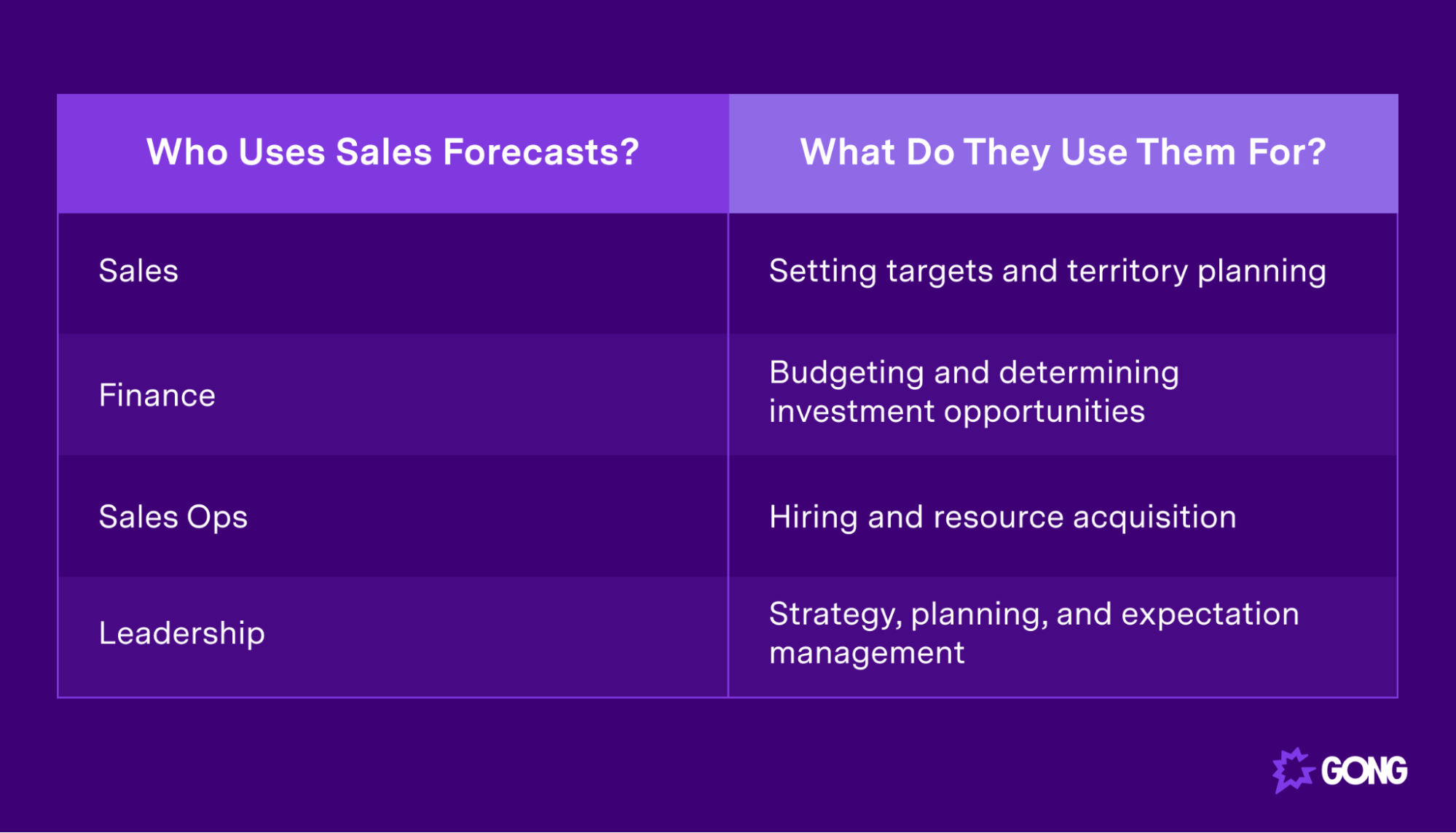
Sales forecasts are used for different purposes by each department. Sales leaders use forecasts for setting targets and territory planning, while HR uses targets to inform their requirement to hire new staff and acquire important resources.
Leadership and finance teams use sales forecasts to inform strategic initiatives, investment opportunities, and company budgets.
How to create a sales forecast
Okay, so how does one actually go about creating a sales forecast?
Here, we’re going to look at the six simple steps that sales forecasting entails. We’re going to use the pipeline-based forecasting method because it provides the most accurate projections and is best suited for enterprise SaaS sales teams.
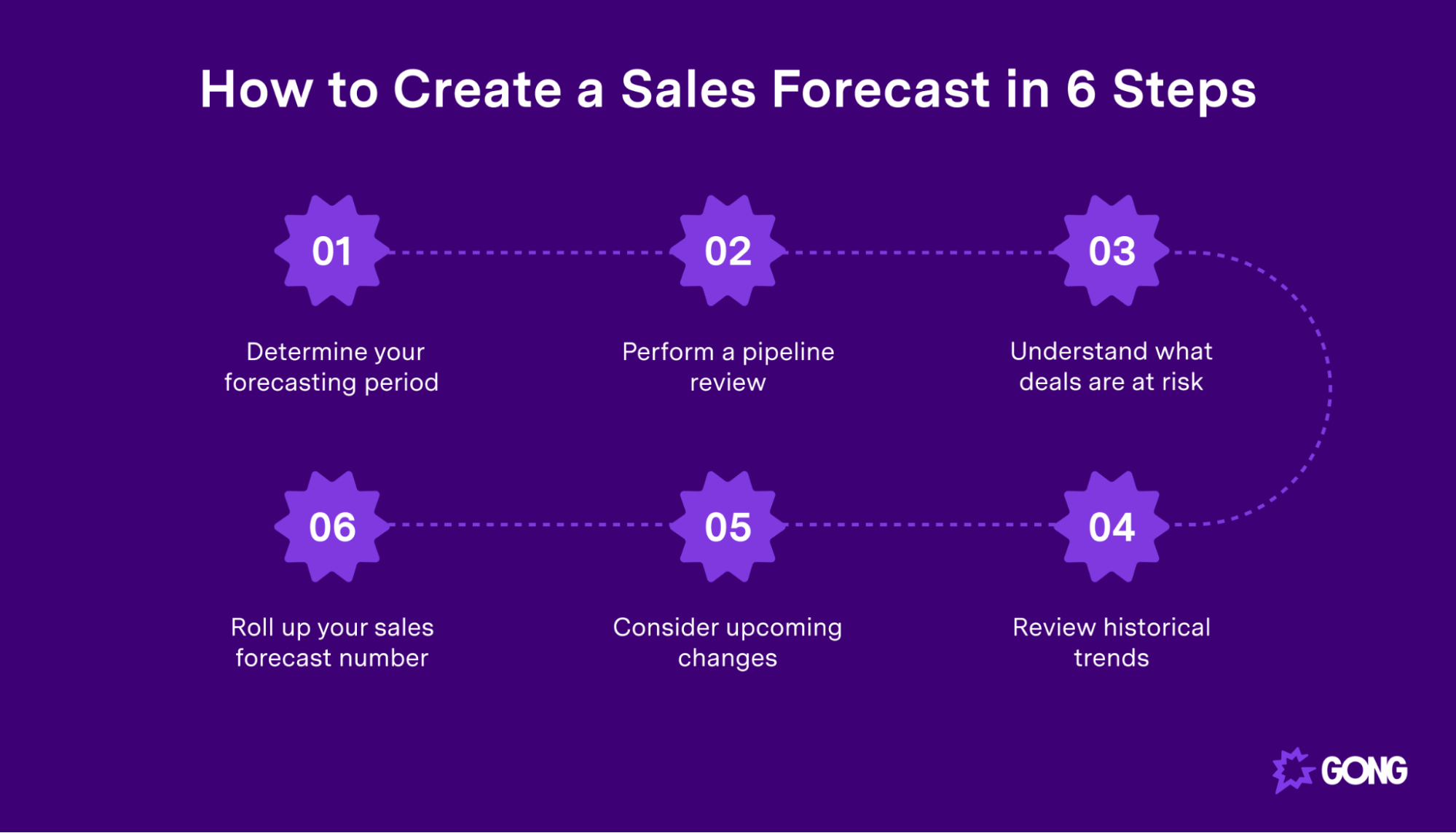
1. Determine your forecasting period
The first step is pretty simple: decide how far out you’re forecasting.
Most organizations will create sales forecasts on a monthly basis, with larger enterprises looking at quarterly forecasts.
That’s really as far as you should be going, to be honest. Annual sales forecasts are too far out, meaning they’re going to be fairly speculative and not all that reliable.
2. Perform a pipeline review
Step two is to set up a pipeline review.
The pipeline review should focus on the future, not on the past. That means we’re not talking about all the deals we’ve closed or the history of every deal.
We want to know:
- Which deals are going to close (and which probably won’t)
- The probability that each will close (certain forecast categories are associated with different probabilities)
- When we can expect them to close (i.e., will they fall into our forecasting period)
Psst, become a pipeline review master with our guide: For Sales Leaders Only: Top Tips for a World-Class Pipeline Review.
3. Understand what deals are at risk
Pipeline-based sales forecasting isn’t just about adding up every deal in the pipeline and calling it a day.
The truth is, not every deal is going to close. Use two processes to determine this.
The first is your historical deal probability at each stage. Your CRM or sales engagement platform should be able to provide that information readily.
The second is a discussion with the sales rep responsible for that lead. Skilled salespeople will have a good gut feeling for close likelihood based on buying signals that were (or weren’t) identified.
4. Review historical trends
While our sales forecast is going to be future-focused, it’s helpful to understand how historical trends might impact your projections.
Look at:
- Current revenue growth rates
- How far your forecasts have been off in the past (you can apply that percentage now for a more accurate estimate)
- Deal stage probabilities
5. Consider upcoming changes
If you’ve got some big stuff in the product pipeline, consider how this might impact your sales forecast.
Let’s say, for instance, you’re creating a forecast for the next quarter. But you know that next month, you’re rolling out a new add-on product, and that’s set to drive a lot of cross-selling revenue from existing clients.
Determine how these changes are expected to impact revenue generation and include this value in your forecast.
6. Roll up your sales forecast number
The last step is just as easy as the first (as long as you don’t mind a little bit of math).
Grab all of the projections from each sales rep and any additional expected revenue from new product roll-outs.
Then, add it all up, multiply the opportunity dollar amount by the forecast category probability (%age), and there’s your sales forecast for the quarter!
Conclusion
Sales forecasting is a critical business activity for high-performing organizations.
It can, however, be a little time-consuming unless you’ve got a powerful sales forecasting platform at hand, of course!
Sales forecasting software helps to automate these processes so you can create forecasts in real-time with minimal effort.
Kick start your sales forecasting right now with our free sales forecast template in Excel, and save yourself the setup time.
